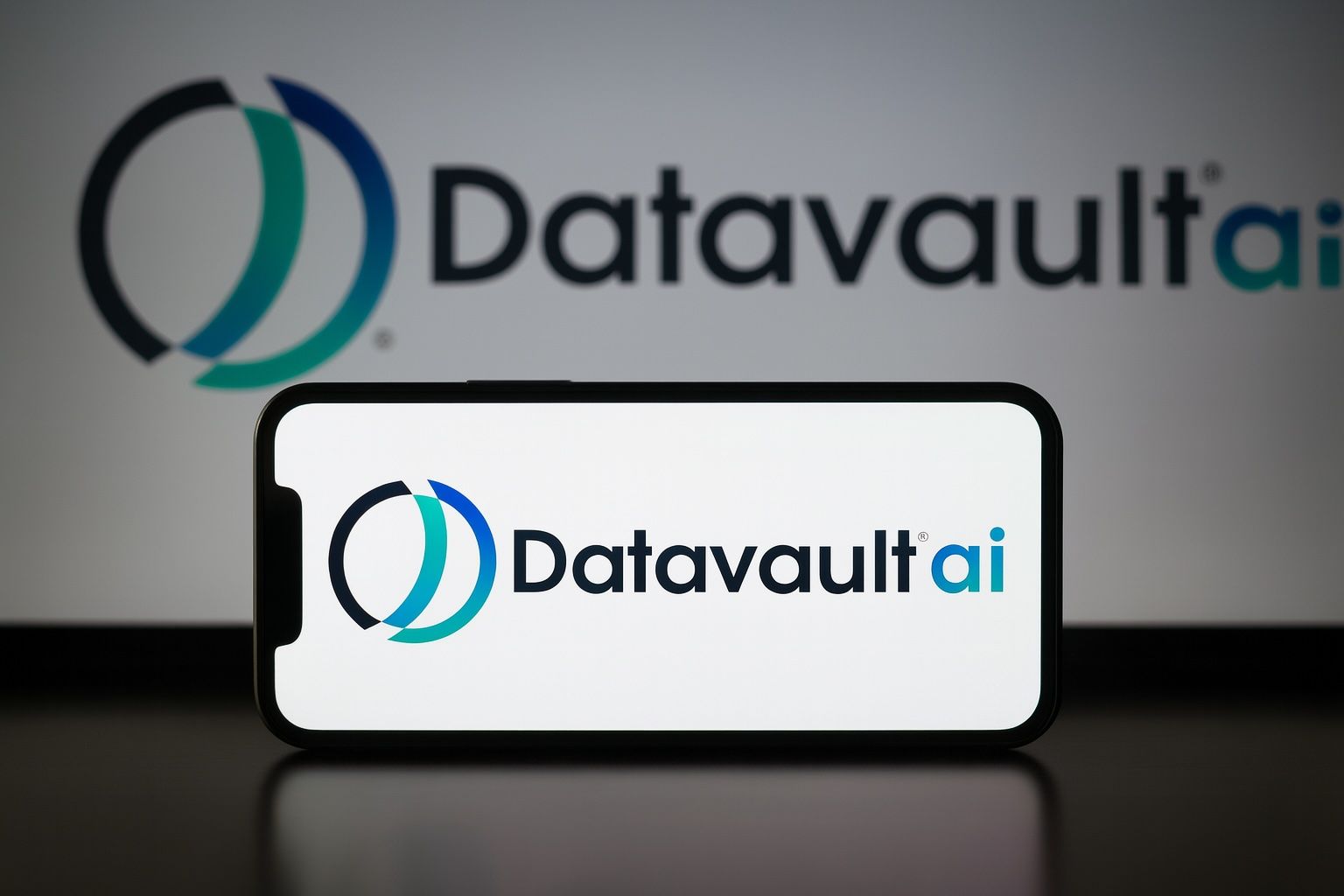- Tiny AI stock surges: Datavault AI (NASDAQ: DVLT) jumped nearly +30% to $2.19 on October 14 after a frenzied month-long rally of over 400%, fueled by AI and crypto buzz [1] [2]. The volatile penny stock’s wild swing has seen it spike from under $0.50 in September to recent highs around $3, vastly outpacing the S&P 500.
- Bitcoin-funded lifeline: DVLT secured a $150 million investment from biotech firm Scilex – uniquely paid in Bitcoin – to supercharge its AI data infrastructure [3]. The crypto-funded deal (in two tranches) gives Datavault a major capital infusion for building supercomputing capacity and data exchanges, leveraging ties with IBM’s watsonx and Brookhaven Lab [4].
- New acquisition & partnerships: On Oct. 13, Datavault signed a letter of intent to acquire NYIAX Inc., a blockchain-based advertising exchange operator [5]. This move expands DVLT’s patented Information Data Exchange platform by adding NYIAX’s trading technology, enabling new marketplaces (for data, NIL rights, even political info) set to launch in coming quarters [6]. High-profile collaborations – including IBM committing 20,000 hours of tech support [7] – and partnerships with industry giants have bolstered DVLT’s credibility [8] [9].
- Analysts divided on DVLT:Maxim Group recently initiated coverage at Buy with a $3.00 price target (≈140% upside) citing Datavault’s blue-chip deals [10], but others urge caution. Weiss Ratings reiterated a Sell in early October [11]. Overall, only a few analysts cover DVLT, yielding a “Moderate Buy” consensus and an average 12-month target around $7 – with a low estimate of $3 and a high of $11 [12]. Bulls argue the tiny company is entering a hyper-growth phase (expected triple-digit revenue jumps this year and next) [13], while skeptics point to ongoing losses (–$0.54 EPS last quarter) and heavy dilution risks [14] [15].
- Volatility, hype & outlook: DVLT’s wild trading reflects retail frenzy. The stock consistently closed above $1 through early October, regaining Nasdaq compliance after a spring listing warning [16]. Volume has exploded (79+ million shares on Oct. 14) as day traders piled in, and short interest over 20% of float has sparked chatter of a short squeeze [17] [18]. Technical signals remain broadly bullish in the short term – rising volume, moving-average buy signals, and a strong upward trend channel [19] – but extreme volatility (20–30% swings per day) makes this a high-risk ride. Looking ahead, key catalysts loom: DVLT is due to report Q3 earnings in early November and will seek shareholder approval for the second $142M Bitcoin tranche. Investors are watching whether management can convert its big plans – integrating NYIAX, launching new data exchanges, and scaling its AI platform – into real revenues. Forecasts diverge: some foresee further upside (technical models suggest the stock could push higher within its trend) [20], while others warn the meteoric rally may fizzle back toward $1–$1.50 if momentum fades [21]. In short, Datavault AI has captured the market’s imagination with its audacious crypto-funded strategy and AI ambitions – now it must deliver results to justify the hype.
DVLT Stock Soars on AI & Bitcoin Buzz
Datavault AI’s stock has been on a gravity-defying run in recent weeks. On October 14, DVLT surged +28.8% in a single session to close at $2.19 [22]. That capped an astonishing rally – shares are up roughly 400% from mid-September levels, when they traded around 50 cents. The tiny Nasdaq-listed company (formerly known as WiSA Technologies) rebranded this year to focus on AI-driven data monetization, and it has suddenly become a retail trader favorite amid 2025’s AI stock frenzy. For context, DVLT’s 52-week range spans from a mere $0.25 up to about $3.10 [23]. In the past two weeks alone, the stock has more than doubled, posting a +100% gain with massive volume inflows [24].
Such explosive momentum has come with extreme volatility. In early October the stock briefly spiked above $2.50, then pulled back to $1.70 by Oct. 13 before roaring higher again [25]. Even a positive news announcement on Oct. 10 – that Datavault had regained Nasdaq listing compliance after 10 straight days above $1 – triggered a puzzling sell-the-news reaction, with DVLT tumbling 15% intraday that day [26] [27]. Analysts suggest some traders likely “bought the rumor” of compliance and took profits once it became official [28]. Nonetheless, the downturn was short-lived. By the next trading day, buyers aggressively returned, and DVLT quickly rebounded, illustrating the turbulent (yet net upward) trajectory of this micro-cap stock.
At a current price in the low $2s, Datavault AI’s market capitalization is only around $200 million – still a micro-cap by market standards. The stock’s meteoric rise appears to be driven less by traditional fundamentals and more by a potent mix of AI hype, strategic deals, and retail speculation. Datavault AI has successfully tapped into the market’s appetite for anything AI-related, and its recent moves (from an eye-catching crypto funding deal to new partnerships) have given traders plenty to latch onto. The result: DVLT has effectively transformed from an obscure penny stock into a buzzy AI play in a matter of weeks. The central question now is whether this rally can be justified – or sustained – as reality catches up with exuberance.
Bitcoin-Funded $150M Lifeline Accelerates AI Ambitions
One of the catalysts propelling DVLT’s surge is a truly unusual financing deal. In late September, Datavault AI announced a $150 million strategic investment from Scilex Holding Company (NASDAQ: SCLX) – with the kicker that the payment will be made entirely in Bitcoin [29]. This is a highly unconventional funding approach for a Nasdaq-listed tech firm. The transaction is structured in two tranches: an initial ~$8.1 million tranche (15 million shares) which closed on Sept. 26, and a much larger ~$141.9 million second tranche (requiring shareholder approval due to Nasdaq’s 20% dilution cap) to follow [30]. Scilex, a biotech company, will ultimately receive up to 278.9 million DVLT shares at an effective price of $0.5378 if the full deal completes [31]. In essence, Datavault secured a massive cash infusion (via digital currency) without immediate heavy dilution – an innovative but complex lifeline that grabbed investors’ attention.
Why Bitcoin? Datavault’s CEO Nathaniel Bradley framed the crypto-funded deal as “jet fuel” for the company’s AI and data monetization strategy [32]. By accepting Bitcoin at market rates (through Coinbase) instead of cash, DVLT leaned into its Web3 ethos and possibly attracted new investor interest from the crypto community. The $150 million (one of the largest investments ever in a micro-cap like DVLT) is earmarked to build out Datavault’s supercomputing infrastructure and expand its independent data exchange platforms [33]. Management says these funds will accelerate several high-profile projects – for example, establishing advanced AI computing clusters and launching secure data marketplaces targeting industries like biotech and finance [34]. Notably, Datavault has been collaborating with Brookhaven National Laboratory and IBM’s watsonx division on its computing initiatives [35], so the new capital could help deepen those partnerships.
The deal also came with strategic perks for the investor. Scilex obtained board nomination rights (up to two seats) and other protections, signaling its commitment to the venture [36]. From Datavault’s perspective, however, the immediate benefit was narrative-driven: the announcement instantly thrust DVLT into 2025’s red-hot “AI infrastructure” storyline [37]. Suddenly, Datavault was being talked about in the same breath as other AI hardware and data plays, despite its tiny size. The stock exploded 28% the day the news hit, and even rallied ~38% pre-market as traders digested the Bitcoin angle and what it might mean [38]. As one analyst noted, using Bitcoin for funding “is unusual for U.S. tech micro-caps and introduces crypto price risk,” but it also “immediately elevates DVLT into the wider AI-infrastructure narrative” of 2025 [39]. In short, this bold financing move gave Datavault both cash and credibility in the AI race – at least in the eyes of speculative investors.
The Scilex investment is still pending its second phase, which will require DVLT shareholders to approve issuing that huge block of additional shares. If approved (likely in coming months), it would massively dilute existing shareholders – roughly quadrupling the share count – although the company would have the full $150M war chest to deploy. In the meantime, Datavault agreed not to issue other equity for 45 days around the deal [40], effectively pausing dilution and perhaps helping fuel the stock’s scarcity-driven rise. The Bitcoin angle also means DVLT is now indirectly exposed to crypto volatility; the funds are held in BTC until converted. Executives insist this capital will be put to productive use: beyond hardware, some proceeds may support DVLT’s growing suite of patented technologies in data tokenization and acoustic AI. The company’s two divisions – Acoustic Science (including its legacy WiSA® wireless audio tech) and Data Science – both stand to benefit from the investment as DVLT pushes into “Web 3.0 data monetization” services [41] [42]. Ultimately, the success of this Bitcoin bet will be judged by whether Datavault can rapidly scale up its platform and start generating meaningful revenue from its AI and data initiatives.
New Acquisition: DVLT to Absorb NYIAX for Data Exchange Expansion
Datavault’s big funding news was soon followed by another major development: a plan to acquire NYIAX Inc. – a New York-based fintech/adtech company – to bolster DVLT’s data monetization ecosystem. On October 13, Datavault AI announced it has signed a Letter of Intent (LOI) to acquire NYIAX, which operates a blockchain-powered exchange for trading advertising and data contracts [43]. This strategic takeover is poised to bring NYIAX’s entire technology platform, patent portfolio, and client network under the Datavault umbrella, significantly expanding Datavault’s commercial footprint in the data exchange market [44].
For Datavault, the deal is a natural extension of an existing relationship. Earlier this year, DVLT had licensed its patented ADIO® ultrasonic technology (used for embedding inaudible data in audio streams) to NYIAX for ad applications [45] [46]. By moving to acquire NYIAX outright, Datavault aims to fully integrate that tech and more. The combined company would marry DVLT’s AI-driven data valuation tools with NYIAX’s proprietary trading platform (which notably was built in partnership with Nasdaq’s technology) [47]. In practical terms, Datavault says this will enable new exchange marketplaces it has been incubating – including an “International Elements Exchange” for digital assets, an NIL (Name-Image-Likeness) rights exchange, and even an American Political data exchange – all slated to debut in the next couple of quarters [48]. These platforms would allow secure, real-time trading of various data-backed assets (from sports and entertainment data to political insights), backed by blockchain and AI analytics for trust and transparency [49] [50].
Executives on both sides heralded the LOI as transformative. “This acquisition will mark a transformative milestone for Datavault AI, uniting our AI expertise with NYIAX’s proven exchange technology to create unparalleled value in data monetization,” said DVLT CEO Nathaniel Bradley [51]. NYIAX’s CEO Teri Gallo likewise noted that combining forces will “redefine how markets operate” by merging financial-market rigor with innovative, privacy-first tech across industries [52]. In essence, Datavault is positioning itself as a leader in “Web 3.0” data trading – enabling companies to treat data as an asset that can be tokenized, bought, and sold in regulated exchange-like environments.
The acquisition, expected to close by Q1 2026 (pending due diligence, definitive agreements, and Nasdaq sign-off), underscores Datavault’s aggressive growth-through-partnership strategy. It builds on DVLT’s earlier partnerships with blue-chip players: for example, Datavault has an agreement with IBM in which IBM will contribute 20,000 hours of technical expertise to help scale DVLT’s platform for enterprise use [53]. (IBM’s global reach and cloud know-how could help Datavault with things like integrating data exchanges into corporate workflows.) Likewise, Datavault’s collaboration with Brookhaven Lab provides access to high-performance computing resources and domain expertise in data analytics. These alliances, coupled now with acquiring NYIAX’s exchange tech, form a picture of a company trying to fast-track its technology and market presence by leveraging established players.
Investors have cheered the NYIAX announcement as it adds another compelling narrative: Datavault isn’t just sitting on the $150M crypto investment; it’s deploying an M&A strategy to broaden its platform and patent portfolio. The NYIAX platform, which blends blockchain with Nasdaq’s financial infrastructure, will grant DVLT a ready-built marketplace product and relationships in the advertising sector [54] [55]. Importantly, it may help Datavault monetize its own tech (like the ADIO ultrasonic ad system and DataVault’s DataScore®/DataBank® valuation tools) by providing a marketplace to use them [56] [57]. If the acquisition closes and integration succeeds, Datavault AI could emerge with a unique end-to-end offering: from capturing and tokenizing data, to valuing it with AI, to trading it on an exchange.
For now, the LOI is another forward-looking promise. The market’s positive reaction suggests traders believe these moves increase DVLT’s long-term value proposition. However, it also raises the bar: Datavault will need to execute on integrating NYIAX and launching these new exchanges in 2026. Any delays or difficulties (regulatory approvals, technical challenges, or culture clash) could temper the enthusiasm. Still, as of mid-October, the NYIAX news has only added fuel to DVLT’s fire, reinforcing the idea that this little company is building something much larger at the intersection of AI, advertising, and blockchain.
Analysts and Experts: Big Price Targets vs. Big Risks
The jaw-dropping rally in DVLT has drawn a range of reactions from market analysts – from outright skepticism to optimistic cheerleading. Wall Street coverage of Datavault AI is limited (only a few small-cap analysts currently formally cover the stock), but their opinions highlight just how polarizing this speculative AI play has become.
On the bullish side, Maxim Group analysts have embraced DVLT’s story. In late September, Maxim initiated coverage with a “Buy” rating and a $3.00 price target, citing Datavault’s high-profile partnerships and innovative data monetization model [58]. At the time, DVLT was trading around $1.25, so Maxim’s target implied enormous upside (roughly +140%). The analysts highlighted Datavault’s deals with industry giants like IBM and its focus on hot sectors (AI, blockchain, Web3) as reasons the stock could rerate higher [59] [60]. Similarly, a Benzinga profile in late September dubbed Datavault and New Era Energy (another micro-cap) “AI penny stock powerhouses,” noting DVLT’s “partnerships with industry giants” and underscoring that Maxim’s $3 target suggested substantial upside [61] [62]. In short, the bulls see Datavault as an early-stage tech innovator that’s now backed by serious funding – a combination that, if executed well, could justify a much higher valuation.
Datavault’s consensus analyst forecast is even more striking. According to MarketBeat data, the average 12-month price target for DVLT is about $7.00 per share, implying roughly +220% upside from current levels [63]. This consensus comes from a very small sample (reportedly 3 analysts), but it reflects one high-end estimate as well. Indeed, the range of targets is wide: the lowest analyst target is around $3 (essentially Maxim’s view), while the highest is up near $11 [64]. The average lands at $7, suggesting that at least one analyst believes DVLT – currently a $2 stock – could potentially more than triple as the company’s AI and data exchange business ramps up. Ratings-wise, those 3 analysts are split: as of this month, one rates DVLT a Strong Buy, one a Buy, and one a Sell, which averages out to a somewhat misleading “Moderate Buy” label [65] [66]. In reality, it’s clear there is no real consensus – just divergent views on a very speculative name.
The bearish or cautious perspective centers on the company’s fundamentals and trading dynamics. Weiss Ratings, for example, reiterated a “sell (E+)” rating on DVLT on October 8 [67], essentially suggesting that the stock’s risk far outweighs any near-term reward. And on September 26 (just after the Bitcoin deal news), research site WallStreetZen actually upgraded Datavault – but only from a stronger sell to a slightly milder “Sell” rating [68]. These cautious takes underscore that Datavault is still very much a work-in-progress business. The company remains deeply unprofitable (it last reported a quarterly loss of –$0.54 per share with a negative 94% return on equity, reflecting ongoing cash burn and minimal revenue) [69]. In fact, DVLT’s revenue in Q2 2025 was only about $1.7 million [70] – a drop in the bucket compared to the multi-million-dollar market cap it’s now commanding. Bears worry that even $150M in funding can evaporate quickly for a company with such high expenses and ambitious R&D plans, and they point out that dilution is on the horizon if the second Scilex tranche closes (potentially flooding the market with hundreds of millions of new shares at roughly $0.54 each).
Another major concern is the trading profile of DVLT’s stock. According to MarketBeat, institutional ownership of Datavault is effectively negligible – under 1% [71]. In other words, the recent rally has been almost entirely driven by retail traders, not long-term institutional investors. “The stock price increase is entirely due to retail traders, with minimal activity from analysts and institutions,” notes MarketBeat’s Thomas Hughes [72]. That dynamic can cut both ways. On one hand, retail enthusiasm has proven powerful (there’s a Reddit/WallStreetBets-style element to how DVLT has skyrocketed on narrative rather than fundamentals). On the other hand, the lack of firm institutional support could make the stock’s gains fragile – if momentum stalls, there may be few big buyers to catch the fall.
Hughes, who wrote an in-depth analysis titled “Datavault: A Speculative AI Play, But Beware of Volatility,” urges caution despite acknowledging DVLT’s potential [73] [74]. He notes that short interest in Datavault spiked to over 20% of the float in late September – near record highs – indicating many traders are betting on the stock’s decline [75]. That heavy shorting can create a headwind, and possibly cap further gains, unless bullish momentum overwhelms it. (It also creates conditions for a short squeeze if positive news keeps hitting – a fact not lost on some retail bulls who have circulated posts about “someone shorting 37 million shares below $1… at the mercy of a squeeze!” on social media.) Hughes also mentions the risk of a pullback to around $1.50 or lower if Datavault fails to deliver concrete results soon [76]. With no major Wall Street firms yet backing DVLT, any stumble could see the stock give back a large chunk of its recent gains.
Yet, Datavault’s management and bulls remain confident that the company’s moves will validate the optimism. Executives tout that 2025 and 2026 could bring “hypergrowth” – projecting DVLT’s revenue to increase by high triple-digit percentages in the next year (off a tiny base) as its deals and products start contributing [77]. If those forecasts even come close, the current analyst price targets might be justified. But that’s a big if. With DVLT trading at over 80 times its trailing sales (a valuation many magnitudes higher than established tech stocks), any sign of disappointment could trigger a sharp correction. Thus, analysts are effectively split: Is DVLT a forward-looking AI gem worth a speculative bet, or an overextended penny stock vulnerable to reality checks? The answer likely hinges on what the company does in the coming months.
Red-Hot Retail Momentum Meets High Risk: Technicals & Sentiment
There’s no denying that Datavault AI has captured the imagination of the retail trading crowd. The stock’s steep rise, low price, and AI/crypto narrative have made it a popular talking point on platforms like Twitter/X and Reddit. This retail fervor has translated into extraordinary trading volumes – tens of millions of shares exchanging hands daily – and wild price swings that can see DVLT move 20–30% in a single day [78] [79]. Such volatility offers both opportunity and peril for short-term traders.
From a technical analysis standpoint, DVLT’s chart is a roller coaster but one that, remarkably, still shows bullish signals. Short-term and long-term moving averages are trending upward and the shorter-term MA is above the longer-term, which technicians interpret as a buy signal [80]. The stock’s rapid rise has it trading in the middle of a “very wide and strong” rising trend channel – meaning even sizable pullbacks have, so far, still kept the uptrend intact [81]. Notably, trading volume has generally increased on up-days, a positive sign that rallies are supported by conviction (and not fading on low volume) [82] [83]. Momentum indicators like MACD have also flashed bullish due to the sharp gains [84]. All this has led some algorithmic forecasting models to predict DVLT may continue higher: one model calculates a further +70% rise over the next three months is possible if the current trend persists, though with an extremely wide confidence interval ($1.16 to $4.52 range) given the unpredictability [85] [86].
However, no one would call this stock anything but high risk. By one risk metric, DVLT is firmly in the “very high volatility” category – its Bollinger Bands (a volatility gauge) are unusually far apart, reflecting the stock’s massive daily swings [87]. Over the last week, DVLT’s average intraday volatility was around 23% [88]. That means on a typical day the price might gyrate nearly a quarter of its value. Traders are advised to use tight stop-losses (one analysis suggested around $2.07, about 5% below the last close, given how fast things can reverse) [89]. There was indeed a pivot top on October 7 around the $2.50+ level, after which DVLT dropped about 13% in subsequent days [90]. Technical analysts warn that the stock could retest lower support levels – key support points sit around $2.08, then $1.90, and $1.70 (areas of high trading volume previously) [91]. A break below those could signal a deeper correction, especially if negative news or broader market weakness hits.
On social media, Datavault has been a buzzing topic. Some traders gleefully talk of “diamond hands” and squeezing shorts, pointing to the stock’s high short interest as a potential powder keg. (As noted, roughly a fifth of DVLT’s float was sold short as of a couple weeks ago [92]. If the price keeps rising, those shorts could be forced to cover, buying shares back and pushing the price even higher – the classic recipe for a short squeeze). There’s also a meme-stock element: DVLT’s mix of AI + crypto has a certain 2021-era GameStop/AMC vibe, where retail investors rally around a speculative stock with fervor. That said, it hasn’t (yet) reached the absurd levels of social media hype those meme stocks did – DVLT is still somewhat under the radar of the general public compared to bigger names. But in small-cap trading circles, it’s become a star of late.
Sentiment among retail investors appears to be cautiously optimistic but very momentum-driven. When DVLT’s price is moving up, FOMO (fear of missing out) kicks in and more traders pile on – evident in the surging volumes on big green days. Conversely, any negative trigger could see sentiment sour quickly; the Oct. 10 compliance sell-off showed that even good news can spark profit-taking if traders think the rally’s peaked [93] [94]. Importantly, with Nasdaq compliance issues resolved for now, one overhang (the risk of delisting or a forced reverse split) is off the table [95] [96]. That likely has improved sentiment, as DVLT no longer faces an imminent existential stock listing threat.
In summary, the trading climate around DVLT is one of speculative zeal buffered by some justified nerves. The technicals say the trend is your friend – until it isn’t. The huge short position could be fuel for further upside – or a sign that many expect a downfall. And retail sentiment can swing on a dime. Potential investors and traders are thus urged (by virtually every expert commentary) to exercise caution and size any positions appropriately. As one analyst quipped, Datavault can indeed “punch above its weight” in sectors like AI and data services [97], but its thin float and speculative trading mean it “trades more on momentum than fundamentals” [98]. In plainer terms: enjoy the ride, but buckle up.
What’s Next for Datavault AI?
With Datavault’s stock having run so far, so fast, the company now enters a critical phase where it must justify the hype or risk a steep comedown. Here are the key factors and events that will likely determine DVLT’s fate in the near future:
- Earnings and Financials: The next major checkpoint is Datavault’s Q3 2025 earnings report, expected in early November. This will be the first earnings release since the company’s transformation into an AI/crypto market darling. Investors will scrutinize any revenue growth (even small improvements) and, importantly, any guidance or commentary from management about new deals. Right now, DVLT’s financials are modest – trailing 12-month revenue is only a few million dollars, with large losses. But the company claims to be on the cusp of rapid growth. MarketBeat noted that DVLT is “expected to increase its revenue by a high triple-digit amount this year and next”, entering a “hypergrowth” phase [99]. If Q3 numbers or forecasts reinforce that narrative (say, showing early signs of product sales, licensing deals, or even significant backlog/orders), it could validate some of the optimism. Conversely, if results show little progress on monetization, it might remind everyone that DVLT is still essentially a pre-revenue speculative venture, potentially triggering a reality check on the stock’s valuation.
- Closing the Scilex Deal: By mid-November, Datavault’s 45-day standstill on new shares will pass [100], and attention will turn to the shareholder vote for approving the second tranche of the Scilex $150M investment. That vote (date TBD) will be telling. Approval is likely, given the company’s need for capital, but if for some reason it were voted down or delayed, DVLT’s funding outlook would change drastically. Assuming it passes, in Q4 or Q1 the company will receive the remaining ~$142 million (in Bitcoin) from Scilex and issue the corresponding ~264 million shares/warrants [101]. How the market digests that massive dilution will be crucial. Often, when penny stocks issue many new shares at a low price (in this case effectively $0.54), the market price gravitates toward that level over time. Datavault will aim to counteract dilution by demonstrating it can put that money to productive use – essentially “grow into” a higher valuation through revenue generation before the dilution fully materializes. This investment also ties DVLT somewhat to Bitcoin’s fortunes; management will need to manage that treasury wisely (crypto volatility cuts both ways).
- Integration of NYIAX and New Products: If the NYIAX acquisition proceeds to a definitive agreement, Datavault will have a lot on its plate operationally. The deal is expected to close in Q1 2026 [102], but the companies will likely start integration efforts sooner. Over the next few months, we may see updates on pilot programs or beta launches of those new exchanges (e.g. the International Elements Exchange or NIL Exchange that DVLT plans to roll out) [103]. Successful demos or early adoption of these platforms by clients would be a strong proof-point for DVLT’s concept of a data marketplace. Additionally, watch for any new partnerships or contracts that leverage the combined DVLT-NYIAX capabilities. For instance, Datavault might announce that a major advertising firm or a sports league is onboard to use the NIL or ad exchange. Such news could further excite investors. Conversely, radio silence on NYIAX for long could breed skepticism about whether the integration is delivering results.
- IBM and Other Partnerships: The IBM collaboration – providing 20,000 hours of assistance – is an intangible but significant asset [104]. As 2026 nears, investors will want to know: what has IBM’s involvement produced? Is DVLT’s platform significantly more scalable or enterprise-ready thanks to Big Blue? IBM’s name lends credibility, but tangible outcomes (perhaps a co-developed solution or a case study of an IBM client using Datavault’s tech) would lend confidence. Similarly, Datavault’s connections with academic and government partners (like national labs) and any involvement in industry consortia could be catalysts or signals of long-term value.
- Market Sentiment & Macros: Broader market conditions, especially for tech and crypto, will also influence DVLT’s trajectory. In October 2025, U.S. stocks have been choppy amid Fed uncertainty and U.S.-China trade tensions [105]. If the tech sector swoons or if risk appetite dries up, high-fliers like DVLT could see outsized pullbacks. Additionally, Bitcoin’s price could indirectly affect sentiment on DVLT – a surge in BTC might make DVLT’s Bitcoin-funded war chest look even more impressive (or vice versa if BTC falls sharply, though presumably DVLT will convert much of it to cash to avoid that risk). On the retail sentiment front, one thing to monitor is short interest and any coordinated squeeze attempts. If DVLT continues climbing, shorts may start to cover, adding fuel. Alternatively, if DVLT stagnates or dips, shorts might press their bets, adding pressure. Either scenario could amplify volatility. As of mid-October, Datavault’s short interest trend and retail buzz are key sentiment indicators to watch [106].
- Valuation and Reality Check: Ultimately, Datavault AI will need to show that it can turn its innovative tech into commercial success. The current market cap (~$200M at $2+ per share) isn’t enormous, but it’s predicated on future potential rather than present-day financials. The consensus analyst target of $7 suggests some believe DVLT could be worth ~$600M+ in a year [107] – likely assuming successful execution of its exchanges and significant client adoption. If DVLT’s technology (like the ADIO ultrasonic advertising or the Information Data Exchange (IDE) platform) gains traction in industries like entertainment, advertising, or finance, we could see real revenues and possibly even the beginnings of an economic moat (DVLT boasts a growing patent portfolio). On the flip side, if the tech isn’t widely adopted or if larger competitors encroach on the same niche, Datavault might struggle to ever monetize at scale, making its current stock price look expensive.
Forecasts for DVLT are all over the map. Algorithmic predictors (like CoinCodex or StockInvest) often simply extrapolate momentum, which right now skews upward with huge error bars [108] [109]. Human analysts, as discussed, range from a low $3 target to an $11 best-case in 12 months [110]. One thing all seem to agree on: volatility will persist. As MarketBeat’s Thomas Hughes put it, DVLT could “retreat to $1.50… or lower” if it stumbles, yet if it delivers on sky-high expectations, the stock could justify multiples of the current price [111] [112].
For investors, Datavault AI has essentially become a high-stakes “proof-of-concept” story. The coming weeks and months will reveal whether this company can evolve from a speculative stock story into a legitimate growing business in the AI data economy. Keep an eye on that November earnings call for clues – any update on new customer wins, exchange launches, or guidance will be crucial. In the meantime, DVLT will likely remain a headline-grabbing, nerve-testing ride. The stock’s 400% moonshot has delivered windfalls to some and whiplash to others. Going forward, new chapters in the Datavault saga – be it a blowout success or a dramatic pullback – will make for an engrossing story in the intersection of AI, crypto, and the stock market’s speculative fervor.
Sources: Key news releases and analysis from TechStock² (TS2) [113] [114], GlobeNewswire [115] [116], MarketBeat [117] [118], Benzinga [119], CoinCentral [120], and Yahoo/Stockanalysis market data [121]. All information is up-to-date as of Oct. 15, 2025.
References
1. www.marketbeat.com, 2. www.benzinga.com, 3. ts2.tech, 4. ts2.tech, 5. www.globenewswire.com, 6. www.globenewswire.com, 7. www.marketbeat.com, 8. www.marketbeat.com, 9. ts2.tech, 10. www.benzinga.com, 11. www.marketbeat.com, 12. www.marketbeat.com, 13. www.marketbeat.com, 14. www.marketbeat.com, 15. www.marketbeat.com, 16. www.globenewswire.com, 17. www.marketbeat.com, 18. www.marketbeat.com, 19. stockinvest.us, 20. stockinvest.us, 21. www.marketbeat.com, 22. www.marketbeat.com, 23. www.marketbeat.com, 24. stockinvest.us, 25. stockinvest.us, 26. coincentral.com, 27. coincentral.com, 28. coincentral.com, 29. ts2.tech, 30. ts2.tech, 31. ts2.tech, 32. ts2.tech, 33. ts2.tech, 34. ts2.tech, 35. ts2.tech, 36. ts2.tech, 37. ts2.tech, 38. ts2.tech, 39. ts2.tech, 40. ts2.tech, 41. www.globenewswire.com, 42. www.globenewswire.com, 43. www.globenewswire.com, 44. www.globenewswire.com, 45. www.globenewswire.com, 46. www.globenewswire.com, 47. www.globenewswire.com, 48. www.globenewswire.com, 49. www.globenewswire.com, 50. www.globenewswire.com, 51. www.globenewswire.com, 52. www.globenewswire.com, 53. www.marketbeat.com, 54. www.globenewswire.com, 55. www.globenewswire.com, 56. www.globenewswire.com, 57. www.globenewswire.com, 58. www.benzinga.com, 59. www.benzinga.com, 60. www.benzinga.com, 61. www.benzinga.com, 62. www.benzinga.com, 63. www.marketbeat.com, 64. www.marketbeat.com, 65. www.marketbeat.com, 66. www.marketbeat.com, 67. www.marketbeat.com, 68. www.marketbeat.com, 69. www.marketbeat.com, 70. www.marketbeat.com, 71. www.marketbeat.com, 72. www.marketbeat.com, 73. www.marketbeat.com, 74. www.marketbeat.com, 75. www.marketbeat.com, 76. www.marketbeat.com, 77. www.marketbeat.com, 78. stockinvest.us, 79. stockinvest.us, 80. stockinvest.us, 81. stockinvest.us, 82. stockinvest.us, 83. stockinvest.us, 84. stockinvest.us, 85. stockinvest.us, 86. stockinvest.us, 87. stockinvest.us, 88. stockinvest.us, 89. stockinvest.us, 90. stockinvest.us, 91. stockinvest.us, 92. www.marketbeat.com, 93. coincentral.com, 94. coincentral.com, 95. www.globenewswire.com, 96. www.globenewswire.com, 97. www.benzinga.com, 98. ts2.tech, 99. www.marketbeat.com, 100. ts2.tech, 101. ts2.tech, 102. www.globenewswire.com, 103. www.globenewswire.com, 104. www.marketbeat.com, 105. ts2.tech, 106. www.marketbeat.com, 107. www.marketbeat.com, 108. stockinvest.us, 109. stockinvest.us, 110. www.marketbeat.com, 111. www.marketbeat.com, 112. www.marketbeat.com, 113. ts2.tech, 114. ts2.tech, 115. www.globenewswire.com, 116. www.globenewswire.com, 117. www.marketbeat.com, 118. www.marketbeat.com, 119. www.benzinga.com, 120. coincentral.com, 121. www.marketbeat.com







